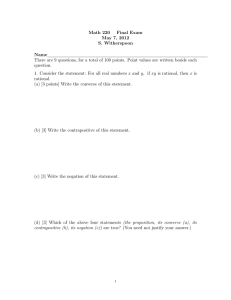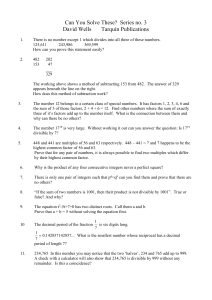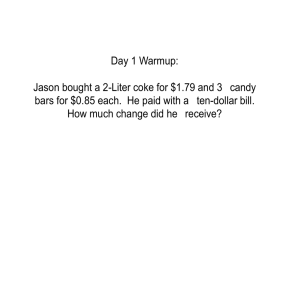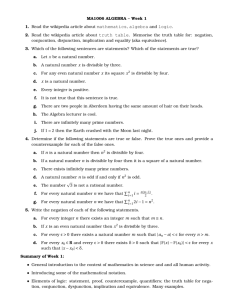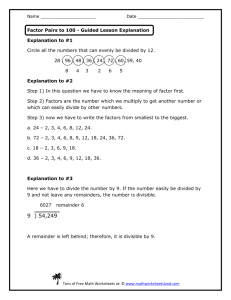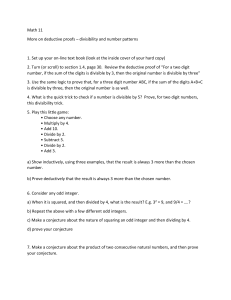Math 220 Final Exam May 7, 2012 Partial Solutions
advertisement
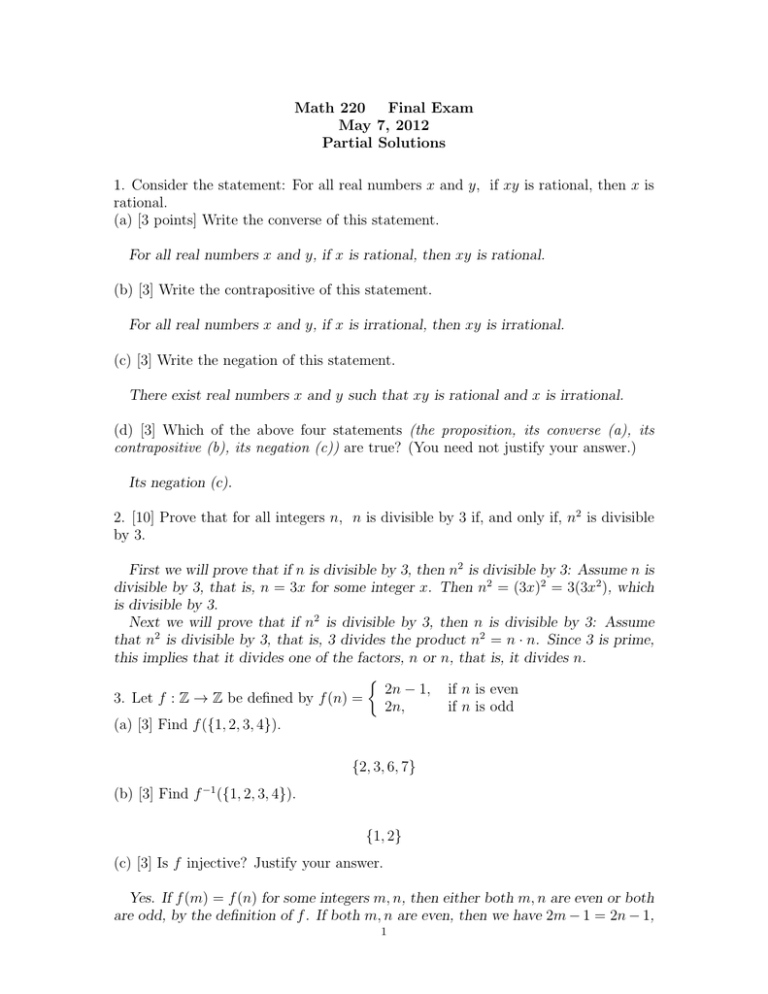
Math 220 Final Exam
May 7, 2012
Partial Solutions
1. Consider the statement: For all real numbers x and y, if xy is rational, then x is
rational.
(a) [3 points] Write the converse of this statement.
For all real numbers x and y, if x is rational, then xy is rational.
(b) [3] Write the contrapositive of this statement.
For all real numbers x and y, if x is irrational, then xy is irrational.
(c) [3] Write the negation of this statement.
There exist real numbers x and y such that xy is rational and x is irrational.
(d) [3] Which of the above four statements (the proposition, its converse (a), its
contrapositive (b), its negation (c)) are true? (You need not justify your answer.)
Its negation (c).
2. [10] Prove that for all integers n, n is divisible by 3 if, and only if, n2 is divisible
by 3.
First we will prove that if n is divisible by 3, then n2 is divisible by 3: Assume n is
divisible by 3, that is, n = 3x for some integer x. Then n2 = (3x)2 = 3(3x2 ), which
is divisible by 3.
Next we will prove that if n2 is divisible by 3, then n is divisible by 3: Assume
that n2 is divisible by 3, that is, 3 divides the product n2 = n · n. Since 3 is prime,
this implies that it divides one of the factors, n or n, that is, it divides n.
2n − 1, if n is even
3. Let f : Z → Z be defined by f (n) =
2n,
if n is odd
(a) [3] Find f ({1, 2, 3, 4}).
{2, 3, 6, 7}
(b) [3] Find f −1 ({1, 2, 3, 4}).
{1, 2}
(c) [3] Is f injective? Justify your answer.
Yes. If f (m) = f (n) for some integers m, n, then either both m, n are even or both
are odd, by the definition of f . If both m, n are even, then we have 2m − 1 = 2n − 1,
1
2
which implies m = n (by adding 1 and dividing by 2 on both sides of the equation).
If both m, n are odd, then we have 2m = 2n, which implies m = n.
(d) [3] Is f surjective? Justify your answer.
No. For example, the number 1 is not in the image of f : If it were, then we would
have 2n − 1 = 1 since odd numbers are images of even numbers and vice versa.
Therefore 2n = 2, so n = 1, but f (1) = 2, a contradiction.
4. Let A and B be sets and let Y be a subset of B.
(a) [5] Let f : A → B be a surjective function. Prove that Y = f (f −1 (Y )).
Let y ∈ Y . Since f is surjective, there is an x ∈ A such that y = f (x). Therefore
x ∈ f −1 (Y ) and y ∈ f (f −1 (Y )). It follows that Y ⊆ f (f −1 (Y )).
Let y ∈ f (f −1 (Y )). Then y = f (x) for some x ∈ f −1 (Y ). Since x ∈ f −1 (Y ), we
have that f (x) ∈ Y . That is, y ∈ Y . This shows that f (f −1 (Y )) ⊆ Y .
We have proven that Y = f (f −1 (Y )).
(b) [5] Show that the assumption that f be surjective in part (a) is necessary, by
giving an example of sets A, B, a subset Y of B, and a function f : A → B for which
Y 6= f (f −1 (Y )).
One example is: Let A = R, B = R, and let f : R → R be the function defined
by f (x) = x2 . Let Y = [−1, 1]. Then f −1 (Y ) = [−1, 1] and f (f −1 (Y )) = [0, 1]. So
Y 6= f (f −1 (Y )).
5. [14] Prove by induction that for each positive integer n,
1 + 3 + 5 + · · · + (2n − 1) = n2 .
First check that the statement is true when n = 1: The left side of the equation is
1, and the right side of the equation is 12 = 1.
Next assume the statement is true when n = k for some positive integer k, that is,
assume that
1 + 3 + 5 + · · · + (2k − 1) = k 2 .
Then
1 + 3 + 5 + · · · + (2k − 1) + (2(k + 1) − 1) =
=
=
=
as desired.
6. (a) [5] Use the Euclidean algorithm to find (91, 35).
7.
k 2 + (2(k + 1) − 1)
k 2 + 2k + 2 − 1
k 2 + 2k + 1
(k + 1)2 ,
3
(b) [5] Find integers x and y such that (91, 35) = 91x + 35y.
x = 2, y = −5.
7. [12] Let R be the relation on Z defined by aRb if a ≤ b + 1. Determine whether R
is reflexive, symmetric, or transitive. Justify your answer.
R is reflexive: a ≤ a + 1 for all a ∈ Z, so aRa for all a ∈ Z.
R is not symmetric: For example, if a = 0 and b = 2, then aRb but it is not true
that bRa.
R is not transitive: For example, if a = 2, b = 1, c = 0, then aRb and bRc, but it
is not true that aRc.
8. [10] Find the least positive integer x that satisfies the congruence
4x ≡ 32(mod 9).
Note that 4 · 7 = 28, which is equivalent to 1 modulo 9. Also, 32 is equivalent
to 5 modulo 9. Multiplying both sides of the equation by 7, we then have that x is
equivalent to 7 · 5 = 35 ≡ 8, so x = 8 is the answer.
1
defines a bijection from R+ (the set
1 + x2
of positive real numbers) to the open interval (0, 1).
9. [10] Prove that the function f (x) =
First note that if x ∈ R+ then f (x) ∈ (0, 1).
1
1
f is injective: Let x1 , x2 ∈ R+ such that f (x1 ) = f (x2 ). That is, 1+x
2 = 1+x2 , and
1
2
we may solve this equation e.g. for x1 to obtain x1 = x2 . (Note that at one point in
the solution process, we need to take the square root of both sides of the equation
x21 = x22 . In general, this would result in two solutions, x1 = ±x2 . However, we have
assumed that both x1 and x2 are positive, so we only take the positive solution.)
+
f is surjective: Let y ∈ (0, 1). We wish to show that there
q is an x ∈ R for which
y = f (x), that is, y =
1
.
1+x2
Solving for x, we obtain x =
1−y
,
y
which is an element
of R+ , as desired. So y = f (x) for this value of x. (Note that in solving the equation,
at one step we need to take the square root of both sides, and so we need to consider
the negative square root as well as the positive square root. However, we were only
interested in the positive square root, since we wanted to find a value in R+ .)
